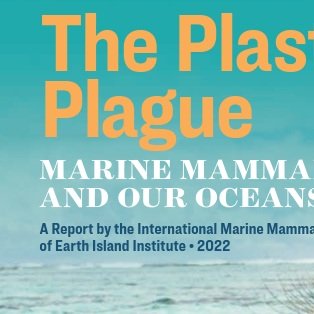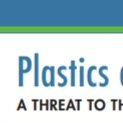
An Introduction to Plastics and Toxic Chemicals
The health and environmental impacts of plastics are a global crisis. Scientific evidence shows that we have broken through the “planetary boundaries” for chemical and plastics pollution, meaning that production and emissions may be threatening the stability of the entire global ecosystem. To best understand what plastics pollution is, one must understand what plastic is: a material made from carbon (fossil fuels) and chemicals. Plastics do not exist without chemicals, and harmful chemicals are released at every phase of the plastics life cycle – from oil extraction to plastics production, transport, use, and disposal.

Field Measurements Reveal Exposure Risk to Microplastic Ingestion by Filter-Feeding Megafauna
Per day, a krill-obligate blue whale may ingest 10 million pieces of microplastic, while a fish-feeding humpback whale likely ingests 200,000 pieces of microplastic. For species struggling to recover from historical whaling alongside other anthropogenic pressures, our findings suggest that the cumulative impacts of multiple stressors require further attention.

Invisible, Unbreakable, Unnatural: PFAS Contamination of U.S. Surface Waters
While PFAS compounds are believed to be ubiquitous in U.S. waterways, no nationwide surface water quality survey exists. As a result, the levels and effects of PFAS are unknown for many rivers, streams, lakes, and other U.S. surface waters that serve as drinking water sources, recreational waters, and fisheries. To address this troubling lack of information about the presence of, and dangers posed by, PFAS in U.S. surface waters, Waterkeeper Alliance contracted with Cyclopure, Inc., a materials science and environmental engineering firm headquartered in Illinois, to help conduct a monitoring project in which we worked with more than 100 Waterkeeper groups across the United States on an unprecedented initiative to test U.S. surface waters for PFAS contamination.

The Price of Plastic Pollution: Social Costs and Corporate Liabilities
Plastics harm people, the environment, and the economy (“social costs”). Some social costs will inevitably turn into compensation claims against the plastics industry (“corporate liabilities”), which may present these claims to their insurers. In this report, for the first time, we provide quantitative estimates of both the social costs and the corporate liabilities emerging from all forms of plastic-related pollution.

It’s as If They’re Poisoning Us’: The Health Impacts of Plastic Recycling in Turkey.
Plastic recycling in Turkey is harming the health of many people and degrading the environment for everyone, Human Rights Watch said in a report released today. The 88-page report, “‘It’s as If They’re Poisoning Us’: The Health Impacts of Plastic Recycling in Turkey,” documents the consequences of the Turkish government’s ineffective response to the health and environmental impacts of plastic recycling on the right to health.

Tracking Trends in Advanced/Chemical “Recycling”
In 2020, GAIA released an alert identifying an alarming trend: legislators were introducing bills to promote the expansion of so-called “chemical recycling” (also known as “advanced recycling”, “waste-to-fuel”, “waste-to-plastic,” “plastic transformation,” and “plastics renewal”), eight of which had been signed into law. This unproven waste management strategy is endorsed by the plastic industry via its lobbying arm, the American Chemistry Council. This alert is an update on that trend, which the petrochemical industry has accelerated.

The Plastics Plague: Marine Mammals and Our Oceans in Peril
A new report, “The Plastics Plague: Marine Mammals and Our Oceans in Peril,” explores the deadly interactions between marine mammals and plastic, from drowning in plastic nets to ingestion and nervous system damage from plastic toxins.

Raman Microspectroscopy Detection and Characterisation of Microplastics in Human Breastmilk
The evidence of microplastics (MPs) in human breastmilk, coupled with the previous discovery of these microparticles in the human placenta, represents a great concern, since it impacts the extremely vulnerable population of infants. In fact, the chemicals possibly contained in foods, beverages, and personal care products consumed by breastfeeding mothers may be transferred to the offspring, potentially exerting a toxic effect. Hence, it is mandatory to increase efforts in scientific research to deepen the knowledge of the potential health impairment caused by MP internalisation and accumulation, especially in infants, and to assess innovative, useful ways to reduce exposure to these contaminants during pregnancy and lactation.

Plastics in Agriculture – An Environmental Challenge
The Foresight Briefs are published by the United Nations Environment Programme to highlight a hotspot of environmental change, feature an emerging science topic, or discuss a contemporary environmental issue. The public is provided with the opportunity to find out what is happening to their changing environment and the consequences of everyday choices, and to think about future directions for policy. The 29th edition of UNEP’s Foresight Brief explores the use of plastic in agriculture and the significant waste problem this entails which impacts on soil health, biodiversity, productivity and food security.

First Evidence of Microplastics in Antarctic Snow
In recent years, airborne microplastics have been identified in a range of remote environments. However, data throughout the Southern Hemisphere, in particular Antarctica, are largely absent to date. We collected snow samples from 19 sites across the Ross Island region of Antarctica. Suspected microplastic particles were isolated and their composition confirmed using micro-Fourier transform infrared spectroscopy (µFTIR).

The Real Truth About the U.S. Plastics Recycling Rate
The Real Truth About the U.S. Plastics Recycling Rate documents a recycling rate of 5-6% for post-consumer plastic waste in the U.S. for 2021 and reveals that while plastics recycling is on the decline, the per capita generation of plastic waste has increased by 263% since 1980.

Reimagining The Bottle Bill
The escalating climate crisis means we must act now. Deposit Return Systems (DRS) have been proven to be the most effective way to collect the necessary material for post-consumer recycled content use. When designed right a DRS can collect 90% of beverage containers, allowing that material to be recycled into new bottles.

The Big Beverage Playbook For Avoiding Responsibility
Big Beverage companies, including Coca-Cola, PepsiCo, and Nestle, are driving the global plastic pollution crisis. This is due, in large part, to the single-use plastic containers in which they sell their beverages. While all beverage container sales in the United States have skyrocketed in recent years, single-use plastic bottles have become particularly popular among the beverage industry.

Recycling Lies: “Chemical Recycling” Of Plastic Is Just Greenwashing Incineration | NRDC Issue Brief
As public concern grows about mountains of plastic trash, the plastics industry is promoting technologies that it misleadingly calls “chemical recycling” (also known as advanced recycling, molecular recycling, and chemical conversion) and touts as a solution to the plastic crisis. But it is a false solution.

Reckoning With the U.S. Role In Global Ocean Plastic
Reckoning with the U.S. Role in Global Ocean Plastic Waste calls for a national strategy by the end of 2022 to reduce the nation's contribution to global ocean plastic waste at every step - from production to its entry into the environment - including by substantially reducing U.S. solid waste generation.

Plastics and Microplastics: A Threat to the Environment and Health
EHHI reviewed nearly 500 scientific studies for this report and found that each of us ingests and inhales millions of microscopic plastic particles each year. Microplastics carry chemical additives and coatings as well as potentially pathogenic microbes. Disturbingly, their impact on human health is not yet known.

Plastic Waste Management Hazards: Waste-To-Energy, Chemical recycling, and plastic Fuels
With petrochemical companies avoiding fossil fuel carbon liabilities by massively increasing plastic production, the amount of plastic waste generated is set to climb dramatically. This report examines the current and emerging methods by which plastic waste is managed globally and questions whether any of them present a solution to the rapidly accelerating generation of plastic waste.

Plastic Waste Poisoning People in Africa, Asia, Central and Eastern Europe & Latin America
Plastics and food packaging contain chemical contaminants from manufacturing along with many additives to make them inflammable, more flexible, grease-resistant, or sterile, as well as other substances to create many other properties. Many of these additives are toxic and they leak from products during use and can be released during recycling and from recycled products.
This study focuses on persistent organic pollutants (POPs), whose releases are closely related to plastic wastes. The POPs include additives in the plastic as such, as well as unintentionally produced POPs (UPOPs) generated mostly by burning, incineration and/or other thermal treatment of plastics.
Four samples from this study are among the ten highest ever measured levels of chlorinated dioxins in chicken eggs globally.

Amazon’s Plastic Problem Revealed
How Amazon is flooding our communities, environment, and oceans with hundreds of millions of pounds of plastic packaging and how they can stop.

Plastics Pose a Threat to Human Health
Authoritative reports shows plastics and microplastics are pervasive sources of exposure to dangerous endocrine-disrupting chemicals.

